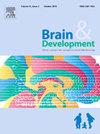电临床生物标志物预测脑电图正常化和多重治疗需要的自限性癫痫与中央颞叶尖峰
IF 1.3
4区 医学
Q4 CLINICAL NEUROLOGY
引用次数: 0
摘要
背景自限性癫痫伴中央颞叶尖峰(SeLECTS)是一种众所周知的儿童自限性局灶性癫痫。虽然中央颞叶放电随着年龄的增长而消退,但预测脑电图正常化和多种治疗需要的时间和生物标志物尚未得到很好的确定。目的本研究旨在确定脑电图缓解的时间和影响脑电图缓解和多药治疗需求的电临床生物标志物。方法回顾性分析2010-2025年全南大学附属医院401例睡眠脑电图正常的select患者(18岁)中的153例。结果睡眠脑电图正常化时的中位年龄为11.4岁(IQR, 10.1 ~ 13.2),中位间隔为45.9个月(IQR, 27.0 ~ 66.8)。癫痫发作年龄与脑电图归一化年龄呈正相关(R = 0.457),与归一化间隔负相关(R = - 0.508; P < 0.001)。单侧放电(10.9 vs. 12.0岁,P = 0.002)或右侧主导型放电(11.2 vs. 13.0岁,P = 0.023)患者的脑电图正常化较年轻。脑电图归一化间隔随着第一次和第二次发作间隔的延长而增加(R = 0.279; P = 0.001)。单侧出院组的时间较短(28.1个月vs. 53.9个月;P < 0.001),而综合治疗组的时间较长(57.3个月vs. 43.5个月;P = 0.006)。综合治疗在儿童早期更为常见(50.5%比21.0%,P = 0.005),在托德麻痹(71.4%比26.0%,P = 0.019)、白天癫痫发作(64.7%比23.5%,P < 0.001)或注意缺陷/多动障碍(ADHD, 66.7%比25.7%,P = 0.015)患者中更为常见。结论脑电图缓解与癫痫发作年龄和偶极子表现相关,而非典型临床因素对多药治疗的影响大于电生物标志物。关键词:儿童;癫痫、中央;脑电图;生物标志物;抗惊厥药物。本文章由计算机程序翻译,如有差异,请以英文原文为准。
Electroclinical biomarkers predicting EEG normalization and polytherapy needs in self-limited epilepsy with centrotemporal spikes
Background
Self-limited epilepsy with centrotemporal spikes (SeLECTS) is a well-known self-limited focal epilepsy in children. While centrotemporal discharges remit with age, the timing and biomarkers predicting EEG normalization and polytherapy needs are not well established.
Purpose
This study aimed to identify the timing of EEG remission and electroclinical biomarkers influencing remission and polytherapy needs in SeLECTS.
Methods
We retrospectively reviewed 153 of 401 patients (<18 years) with SeLECTS whose sleep EEGs normalized (2010–2025, Chonnam National University Hospital).
Results
The median age at sleep EEG normalization was 11.4 years (IQR, 10.1–13.2), with a median interval of 45.9 months (IQR, 27.0–66.8). Seizure-onset age correlated positively with EEG normalization age (R = 0.457) and negatively with the interval to normalization (R = −0.508; P < 0.001). EEG normalized younger in patients with unilateral (10.9 vs. 12.0 years, P = 0.002) or right-dominant discharges (11.2 vs. 13.0 years, P = 0.023). The EEG normalization interval increased with a longer gap between the first and second seizures (R = 0.279; P = 0.001). It was shorter in unilateral discharges (28.1 vs. 53.9 months; P < 0.001), and longer in the polytherapy group (57.3 vs. 43.5 months; P = 0.006). Polytherapy was more frequent in early childhood (50.5 % vs. 21.0 %; P = 0.005), and in patients with Todd's paralysis (71.4 % vs. 26.0 %; P = 0.019), daytime seizures (64.7 % vs. 23.5 %; P < 0.001), or attention deficit/hyperactivity disorder (ADHD; 66.7 % vs. 25.7 %; P = 0.015).
Conclusion
EEG remission is associated with seizure-onset age and dipole findings, whereas the need for polytherapy is influenced more by atypical clinical than electrical biomarkers.
Keywords: Child; epilepsy, rolandic; electroencephalography; biomarkers; anticonvulsants.
求助全文
通过发布文献求助,成功后即可免费获取论文全文。
去求助
来源期刊

Brain & Development
医学-临床神经学
CiteScore
3.60
自引率
0.00%
发文量
153
审稿时长
50 days
期刊介绍:
Brain and Development (ISSN 0387-7604) is the Official Journal of the Japanese Society of Child Neurology, and is aimed to promote clinical child neurology and developmental neuroscience.
The journal is devoted to publishing Review Articles, Full Length Original Papers, Case Reports and Letters to the Editor in the field of Child Neurology and related sciences. Proceedings of meetings, and professional announcements will be published at the Editor''s discretion. Letters concerning articles published in Brain and Development and other relevant issues are also welcome.
 求助内容:
求助内容: 应助结果提醒方式:
应助结果提醒方式:


